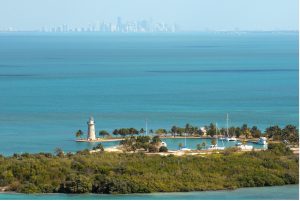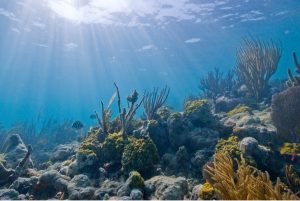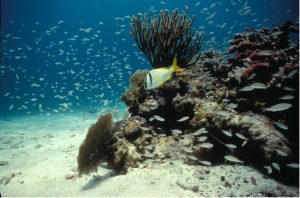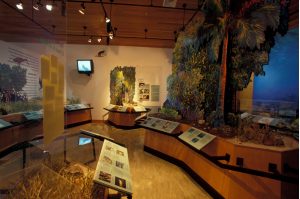
Biscayne offers visitors many watery choices
HOMESTEAD, Fla. — A watery wonderland located right within sight of downtown Miami, called Biscayne National Park, protects a large range of aquamarine waters, pristine islands, and colorful coral reefs home to unique breeds of fish and other underwater life. Biscayne National Park holds human history dating back from more than 10,000 years, with evidence from prehistoric tribes and shipwrecks. Currently, the park provides a perfect outdoor activity destination for fishing, diving, boating, and even learning about its wildlife.
 |
The Miami skyline offers background to the north from the Boca Chita Key in Biscayne National Park (Photos courtesy of the National Park Service). |
Take a guided tour.
Provided by the Biscayne National Institute, guided tours offer “eco-adventures” highlighting various snorkeling experiences, including a shipwreck viewing on the Maritime Heritage Trail and visions of the vibrant coral reefs. Departing from the Dante Fascell Visitor’s Center, tours vary and can include cruising the Biscayne Bay to the Boca Chita Key and lighthouse, admiring the houses of Stiltsville, and exploring the seldomly-seen marvels of Jones Lagoon.
Go fishing.
Biscayne Bay has been used as a means of survival for indigenous groups, like the Tequesta, for over thousands of years. Now, the waters within the park are used to kick back, relax, and enjoy nature around us. Housing rare fish and other unique underwater life, Biscayne National Park allows regulated fishing for enjoyment, customary, and traditional use. The park advises to review all fishing and lobstering regulations, set by the Florida Fish and Wildlife Conservation Commission, before casting your lines.
Rent a kayak or canoe.
Explore the mangrove fringe shorelines and shallow bay waters up close and personal with a canoe or kayak. Launch your paddle craft from the designated areas, such as the popular spot of Adams Key, and explore the seven-mile expanse of Biscayne Bay to Elliott or Boca Chita Key. In the areas too shallow for motorized vessels, renting a canoe or kayak allows you to explore the lagoons, creeks and channels south of Caesar Creek in the peace of your own solitude. Look upon the rays, jellyfish, schools of fish, and wading birds upon the shallow Jones Lagoon or head to Hurricane Creek to observe sea squirts, crabs, anemones, and other marine life.
| Diving and snorkeling can allow visitors to get up and close to the coral reefs and other sea life in the park. |  |
Take a dive or go snorkeling.
Swim directly along the Maritime Heritage Trail to see the historic shipwreck remains of Biscayne National Park. Including a total of six shipwrecks, each craft varies in size and vessel type, with history spanning over a timeline of nearly a century. Access to the trails and diving points are only available by boat. Locations such as Erl King, Alicia, and Lugano are best suited for scuba divers, while other sites, like Mandalay, are best enjoyed while snorkeling. Both provide unparalleled opportunities to experience immense history in a scenic and natural setting.
Go boating.
The sparkling waters surrounding Biscayne National Park flow for more than 250 square miles. Boat along the coastline for calmer waters or head toward the open waters for a slight thrill. Sail off from one of the four Miami-Dade County operated marinas or boat ramps. Homestead Bayfront marina and Black Point marina feed directly into Biscayne National Park, while Matheson Hammock Marina and Crandon Marina operate from the northern end of Biscayne National Park and Key Biscayne.
Camp out.
If just a day isn’t enough time to truly admire Biscayne National Park’s vast and unique landscape, stay overnight at one of the two campgrounds located on the park! Located on the Boca Chita Key and Elliott Key, both campgrounds are only accessible by boat. Keep in mind, no services, aside from bathrooms, (and drinking water and cold showers available only on Elliott Key) are accessible on the islands. Enjoy your stay admiring waterfront views, exploring trails, laying on the grassy camping grounds, and using the provided picnic tables and grills.
| The rare light blue and yellow porkfish swims by the reefs in the Biscayne National Park |  |
Watch the wildlife.
There is a plethora of ways to get to know the wildlife that inhabits Biscayne National Park. Scuba diving, canoeing, or boating as mentioned above are great ways to meet the park’s animal residents. Or allow yourself to take a stroll along the Biscayne Birding Trail where you’ll see a myriad of colorful and rare birds, such as the mangrove cuckoo and shorebirds. The trail is accessible from multiple points across the park, with birds flocking starting from the parking lot from most points. Different locations are homes to different birds, so if you’re on the lookout for a specific bird, be sure to check the park’s official website.
Splash around by the shore.
Children, and inner children alike, love splashing along the rocky shoreline near the visitor center and poking at the local growth. Beautiful swimming beaches exist all around Biscayne National Park, many located at the boating marinas, like Homestead Bayfront, Matheson Hammock and Crandon marinas. Average water temperatures reach 76 degrees Fahrenheit, according to www.climate-data.org, making for a very comfortable swim. However, Miami-Dade County advises to closely monitor the water quality as it significantly varies throughout the year.
 |
The Dante Fascell Visitor Center includes a museum with exhibits highlighting artifacts, informative charts, artwork and park history. |
Visit the museum and art gallery in the Visitor’s Center.
The Dante Fascell Visitor Center on Biscayne National Park offers a variety of free programs and activities, two main attractions being the renowned museum and art gallery. The museum features sound and video exhibits highlighting the park’s four ecosystems and several films spotlighting certain aspects in the park. The visitor’s center art gallery provides a space for artists to display their work inspired by the grounds. Their masterful work plays a crucial role in increasing awareness and inspiring stewardship of national parks across the U.S.
Learn more.
Biscayne National Park is home to and incredible classroom and laboratory for students of all ages. All programs are free of charge and cover a wide variety of subjects, from creating a better understanding of natural and cultural history to improving scientific literacy and appreciation for conservation and stewardship. Majority of Biscayne National Park’s learning program is held out of the Dante Fascell Visitor Center at Convoy Point in Homestead. For a list of current programs, visit their official website.
If You Go
Biscayne National Park:
- Address: 9700 SW 328th St., Homestead, Fla. 33033
- Hours: Park waters are open 24-hours a day all year, including holidays. The Convoy Point grounds are open from 7 a.m. to 5:30 p.m. seven days a week, including holidays.
- COVID response: Masks are mandated in both indoor and outdoor locations regardless of vaccination status. For additional details, visit nps.gov/cornavirus.
- Biscayne National Park advises to review current weather and safety conditions before arrival.
Guided Tours:
- To book a guided tour, visit Biscayne National Park Institute or call 786-335-3644.
- Take a boat cruise: https://www.biscaynenationalparkinstitute.org/boat-cruise/
Fishing:
- Licenses, regulations and restrictions: https://www.nps.gov/bisc/planyourvisit/fishing.htm
Kayaking and Canoeing:
- To book a paddling adventure: https://www.biscaynenationalparkinstitute.org/paddling/
- For water safety: https://www.nps.gov/subjects/healthandsafety/water-vessel-safety.htm
Scuba Diving and Snorkeling:
- To book a snorkeling or scuba diving tour, visit https://www.biscaynenationalparkinstitute.org/snorkeling/
Boating:
- Biscayne National Park boating guide: https://ocean.floridamarine.org/boating_guides/biscayne_bay/
- Sign up for Miami-Dade marina alerts: https://www.miamidade.gov/global/service.page?Mduid_service=ser149122963708133
Camping:
- Campground availability is on a first-come, first-served basis.
- Fees are $24 per night and include tent site and boat docking. Payment must be made using your mobile phone and Scan & Pay: https://www.recreation.gov/mobile-app
- Visit https://www.nps.gov/bisc/planyourvisit/camping.htm for more information.
Wildlife Watching:
- Review the ethical wildlife viewing guidelines: https://www.nps.gov/bisc/planyourvisit/wildlife-viewing.htm
- Check out the various access points on Biscayne Birding Trail: https://www.nps.gov/bisc/planyourvisit/birding-locations.htm
Swimming:
- Many swimming beaches are located at the boating marinas. For marina information, visit: https://www.nps.gov/bisc/planyourvisit/nearby-marinas-access-for-boaters.htm
Museum and Art Gallery:
- The Dante Fascell Visitor Center Gallery official website: https://www.nps.gov/bisc/planyourvisit/the-dante-fascell-visitor-center-gallery.htm
- Hours: The visitor center is open from 9 a.m. to 5 p.m. seven days a week, including holidays.
To Learn More:
- For a list of current programs, visit their official website: https://www.nps.gov/bisc/learn/education/index.htm
- To sign up for a program, fill out their registration form: https://forms.office.com/pages/responsepage.aspx?id=urWTBhhLe02TQfMvQApUlEslcNLxriROkf9Vy1t_Q5hUQ05VRFhFRjNYUzRUV01XS1lLQ0xRQjZTRy4u
- For questions or comments regarding the program, contact the Education Office at 786-335-3690.

Comments are Closed